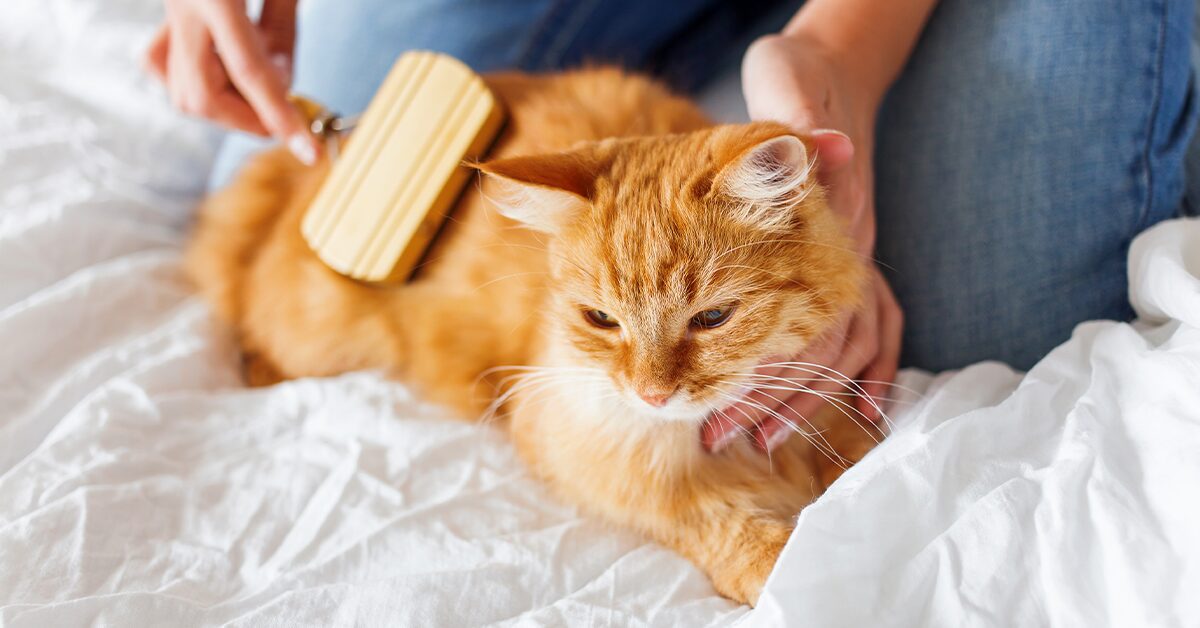Every cat owner knows that felines love to groom themselves. Sometimes it seems all they do is lick – the average cat actually spends an average of 30 to 50 percent of their day self-grooming!
With all that time looking after their fur, you’d think your cat has everything under control in the beauty department. Yet there are some grooming practices you may want to adopt to keep your cat’s fur, skin, and teeth spotless. Simple measures like weekly brushing, regular nail trimming, and occasional ear cleaning will make a big difference in your pet’s long-term health. It can even strengthen the bond between you and your cat, and make your cat more comfortable being held.
Before you get to work, it’s important to read up on best grooming practices for keeping your cat safe during their beauty routine. To help you get started, we’ve assembled our top cat grooming tips below.
1. Start grooming early
Kittenhood is the perfect time to get your cat used to grooming. Kittens are used to being preened by their mothers, which makes them more receptive to being handled and groomed by humans. Remember to be gentle and use positive reinforcement so your kitten learns to enjoy the grooming process.
Of course, it’s possible to start grooming with an older cat, but it may be more challenging if they’re not used to a lot of attention or touching. If your cat is new to grooming, move slowly and introduce new tools, products, and techniques over several months so they don’t get spooked. With a little time and patience, you’ll have a furbulous-looking feline.
2. Before bathtime, prioritize playtime
It’s no secret that cats dislike water – including baths. While cats are generally good at self-grooming and don’t need regular bathing, there may be occasions when they’ll get into some trouble and need a good scrub (smelly and sticky fur? no thanks). The key to doing this with as little fuss as possible is tiring your cat out beforehand.
Before bathtime, break out your cat’s favorite toy and have some fun. After a play session, they’ll be tired, so they’ll have less energy to resist the bathtub. Just in case, consider trimming your cat’s claws before bathtime to keep yourself safe.
3. Use cat shampoo instead of human shampoo
Once you’ve rinsed your cat’s back and neck with lukewarm water, opt for a cat shampoo to clean their fur. Cat shampoos are less drying than human shampoos, making them ideal for your cat’s sensitive skin. Apply the shampoo in the same direction that your cat’s fur grows, from head to tail. Be careful not to get it in their eyes – ouch! – and once they’re clean, give them a good rinse to ensure no soap residue remains. To clean around their face, use a wet washcloth without any soap.
Pet Pro Tip: New to feline dental care? Join the Pumpkin Wellness Club, a new program that actually pays you for getting your cat the routine preventive care that they need to stay healthy. Members have the option to get up to $150 in cash for dental cleanings each year, plus even more savings on vaccines and annual health screenings.
4. Brush them at least once a week
Brushing your cat’s fur will ensure it stays healthy and shiny. A good brushing once or twice a week will remove dirt, dead skin, and other debris for optimal skin and fur health. Have a long-haired cat? Consider bumping up your brushing frequency to twice a week to prevent matting or tangles. A regular brushing routine also helps prevent hairballs by getting rid of excess hair.
5. Invest in proper grooming tools
When it comes to brushing tools, a bristle cat brush or slicker brush is perfect for short-haired cats, while a wide-toothed comb is a better fit for long-haired kitties who may have tangles and mats. For a gentler grooming session, opt for a grooming glove (a de-shedding tool for removing loose hair) and give your cat a nice massage in the process.
6. Clean the underside of their ears
Cleaning your cat’s ears should be part of your grooming routine, especially because they can’t lick these areas clean themselves. Apply a vet-recommended ear cleaner to a cotton ball or pad, and wipe away any dirt or buildup on the underside of the ear. When you’re cleaning, be sure to avoid the ear canal, as it’s extremely sensitive to any probing or pressure. If you notice small black grounds in your cat’s ear, this could be a sign of ear mites, and you should take them to the vet to get their opinion.
7. Familiarize your feline with the sound of cat nail clippers
Help your kitty get used to nail clipping by desensitizing them to the noise. One tip is to place raw spaghetti in the cat nail trimmer and give it a snip while gently pressing on your cat’s paw pad. This way, they associate the noise with slight pressure on their paw, so they are less likely to go running when you test out the clippers on their nails. When you’ve clipped the spaghetti, give your cat a treat so they learn to associate the nail clipper noise with receiving a treat.
8. Clip one or two nails at a time
Once your cat is ready to have their real nails clipped, move slowly and clip one or two nails at a time. Moving too quickly can result in accidentally hurting your pet, which will make them wary of the clippers. Doing only a few nails in a sitting helps ease them into the process. Avoid the sensitive pink base of the nail at all costs, and stick to trimming just the sharp tip of your cat’s claws.
9. Get help from a friend
If your cat is still squirmy after you follow these nail clipping tips, consider reaching out to a friend for help. With one person holding the cat, it’ll be easier for the other to clip the nails. If you still find it difficult to safely clip them, enlist the help of a professional. Most vets and groomers will be happy to trim them for you, and also offer other cat grooming services.
10. Jazz things up with some pet-safe nail polish
Want your kitty to be the talk of the town? Add a splash of color to their nails with some pet-safe polish. There are many brands on the market that are safe, non-toxic, and specifically formulated for pets. You can also purchase a polish pen, which allows you to color directly on the nail without making a mess. While pet-safe polish adds fun pizazz, human polish is never safe for pets. Avoid human polish or nail polish remover to keep your cat healthy.
11. Introduce them to toothpaste gradually
Keeping your cat’s teeth clean is important to ensure optimal dental and gum health, but this is easier said than done. Introduce your cat to the idea of teeth cleaning slowly, first by applying a small amount of cat toothpaste to their mouth, then by giving their gums a little massage with a cotton swab. This will help familiarize them with the taste and feeling, readying them for a real brushing.
12. Buy a cat toothbrush
Rather than use a human toothbrush, which is a bit too large for your kitty’s mouth, buy a toothbrush specifically for cats. Put a bit of cat toothpaste on it and go to work, taking care to brush gently. If you prefer, you can also buy cat toothbrushes that fit on your finger, which are also gentle enough to use on their gums.
13. Use a cat swaddle
Just like blankets can make us feel safer, being wrapped in a swaddle can calm your cat. Also known as a cat burrito, a cat swaddle is a technique for stopping a cat from moving, allowing you to clip their nails or clean their face while making them less stressed. You can make a swaddle using any towel. Simply have your cat lay down at one end of a towel, and gently wrap them with it. Take care not to handle your kitty too forcefully, as this can make them more frightened.
14. Monitor for ticks and fleas
Fleas and ticks are the two most common external parasites that latch onto pets. Run your hand over their skin to feel for any abnormal bumps, which could be ticks embedded in the skin. If you find one, use clean tweezers to grab its head and pull upwards, and clean that area of your cat’s skin afterward.
Fleas, on the other hand, are most easily found through flea dirt – the black specks they leave behind on the skin. If you think you’ve spotted some, check with your vet, who will recommend a proper flea treatment such as a shampoo or spray.
15. Keep an eye out for any skin, ear, or dental concerns
Throughout the grooming process, you’ll get an up-close look at your cat, making it the perfect time to check for any potential health concerns. When brushing, look for any rashes, redness, or hair loss, which could be cause for concern. The same goes for cleaning their teeth and ears. Dark wax or black and yellow discharge could be the sign of an ear infection, while swollen gums or loose teeth can indicate dental issues. If you observe any of these, schedule an appointment with your vet as soon as possible.
Now that you know all our grooming secrets, you’re ready to preen your cat to perfection! For additional help keeping your cat healthy and happy, consider signing up for a Pumpkin Pet Insurance plan.
Pumpkin Pet Insurance policies do not cover pre-existing conditions. Waiting periods, annual deductible, co-insurance, benefit limits and exclusions may apply. For full terms, visit pumpkin.care/insurancepolicy. Products, discounts, and rates may vary and are subject to change. Pumpkin Insurance Services Inc. (Pumpkin) is a licensed insurance agency, not an insurer. Insurance is underwritten by United States Fire Insurance Company, a Crum & Forster Company and produced by Pumpkin. Pumpkin receives compensation based on the premiums for the insurance policies it sells. For more details, visit pumpkin.care/underwriting-information.
All trademarks are the property of Pumpkin or a related company or licensor unless otherwise noted.
Copyright © 2021 Pumpkin Insurance Services Inc. All rights reserved.




